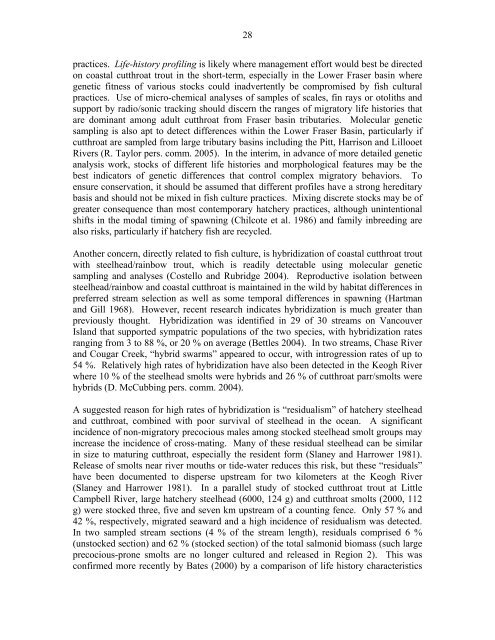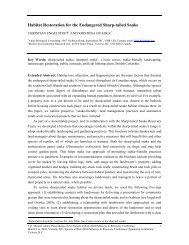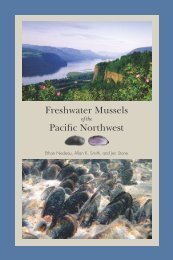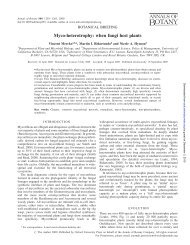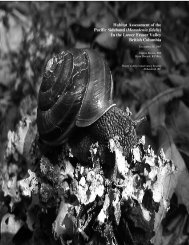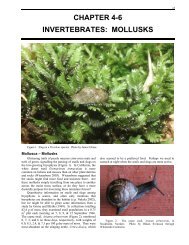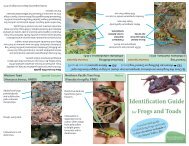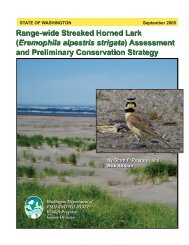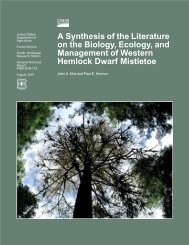Coastal Cutthroat Trout as Sentinels of Lower Mainland Watershed ...
Coastal Cutthroat Trout as Sentinels of Lower Mainland Watershed ...
Coastal Cutthroat Trout as Sentinels of Lower Mainland Watershed ...
You also want an ePaper? Increase the reach of your titles
YUMPU automatically turns print PDFs into web optimized ePapers that Google loves.
28practices. Life-history pr<strong>of</strong>iling is likely where management effort would best be directedon co<strong>as</strong>tal cutthroat trout in the short-term, especially in the <strong>Lower</strong> Fr<strong>as</strong>er b<strong>as</strong>in wheregenetic fitness <strong>of</strong> various stocks could inadvertently be compromised by fish culturalpractices. Use <strong>of</strong> micro-chemical analyses <strong>of</strong> samples <strong>of</strong> scales, fin rays or otoliths andsupport by radio/sonic tracking should discern the ranges <strong>of</strong> migratory life histories thatare dominant among adult cutthroat from Fr<strong>as</strong>er b<strong>as</strong>in tributaries. Molecular geneticsampling is also apt to detect differences within the <strong>Lower</strong> Fr<strong>as</strong>er B<strong>as</strong>in, particularly ifcutthroat are sampled from large tributary b<strong>as</strong>ins including the Pitt, Harrison and LillooetRivers (R. Taylor pers. comm. 2005). In the interim, in advance <strong>of</strong> more detailed geneticanalysis work, stocks <strong>of</strong> different life histories and morphological features may be thebest indicators <strong>of</strong> genetic differences that control complex migratory behaviors. Toensure conservation, it should be <strong>as</strong>sumed that different pr<strong>of</strong>iles have a strong hereditaryb<strong>as</strong>is and should not be mixed in fish culture practices. Mixing discrete stocks may be <strong>of</strong>greater consequence than most contemporary hatchery practices, although unintentionalshifts in the modal timing <strong>of</strong> spawning (Chilcote et al. 1986) and family inbreeding arealso risks, particularly if hatchery fish are recycled.Another concern, directly related to fish culture, is hybridization <strong>of</strong> co<strong>as</strong>tal cutthroat troutwith steelhead/rainbow trout, which is readily detectable using molecular geneticsampling and analyses (Costello and Rubridge 2004). Reproductive isolation betweensteelhead/rainbow and co<strong>as</strong>tal cutthroat is maintained in the wild by habitat differences inpreferred stream selection <strong>as</strong> well <strong>as</strong> some temporal differences in spawning (Hartmanand Gill 1968). However, recent research indicates hybridization is much greater thanpreviously thought. Hybridization w<strong>as</strong> identified in 29 <strong>of</strong> 30 streams on VancouverIsland that supported sympatric populations <strong>of</strong> the two species, with hybridization ratesranging from 3 to 88 %, or 20 % on average (Bettles 2004). In two streams, Ch<strong>as</strong>e Riverand Cougar Creek, “hybrid swarms” appeared to occur, with introgression rates <strong>of</strong> up to54 %. Relatively high rates <strong>of</strong> hybridization have also been detected in the Keogh Riverwhere 10 % <strong>of</strong> the steelhead smolts were hybrids and 26 % <strong>of</strong> cutthroat parr/smolts werehybrids (D. McCubbing pers. comm. 2004).A suggested re<strong>as</strong>on for high rates <strong>of</strong> hybridization is “residualism” <strong>of</strong> hatchery steelheadand cutthroat, combined with poor survival <strong>of</strong> steelhead in the ocean. A significantincidence <strong>of</strong> non-migratory precocious males among stocked steelhead smolt groups mayincre<strong>as</strong>e the incidence <strong>of</strong> cross-mating. Many <strong>of</strong> these residual steelhead can be similarin size to maturing cutthroat, especially the resident form (Slaney and Harrower 1981).Rele<strong>as</strong>e <strong>of</strong> smolts near river mouths or tide-water reduces this risk, but these “residuals”have been documented to disperse upstream for two kilometers at the Keogh River(Slaney and Harrower 1981). In a parallel study <strong>of</strong> stocked cutthroat trout at LittleCampbell River, large hatchery steelhead (6000, 124 g) and cutthroat smolts (2000, 112g) were stocked three, five and seven km upstream <strong>of</strong> a counting fence. Only 57 % and42 %, respectively, migrated seaward and a high incidence <strong>of</strong> residualism w<strong>as</strong> detected.In two sampled stream sections (4 % <strong>of</strong> the stream length), residuals comprised 6 %(unstocked section) and 62 % (stocked section) <strong>of</strong> the total salmonid biom<strong>as</strong>s (such largeprecocious-prone smolts are no longer cultured and rele<strong>as</strong>ed in Region 2). This w<strong>as</strong>confirmed more recently by Bates (2000) by a comparison <strong>of</strong> life history characteristics


